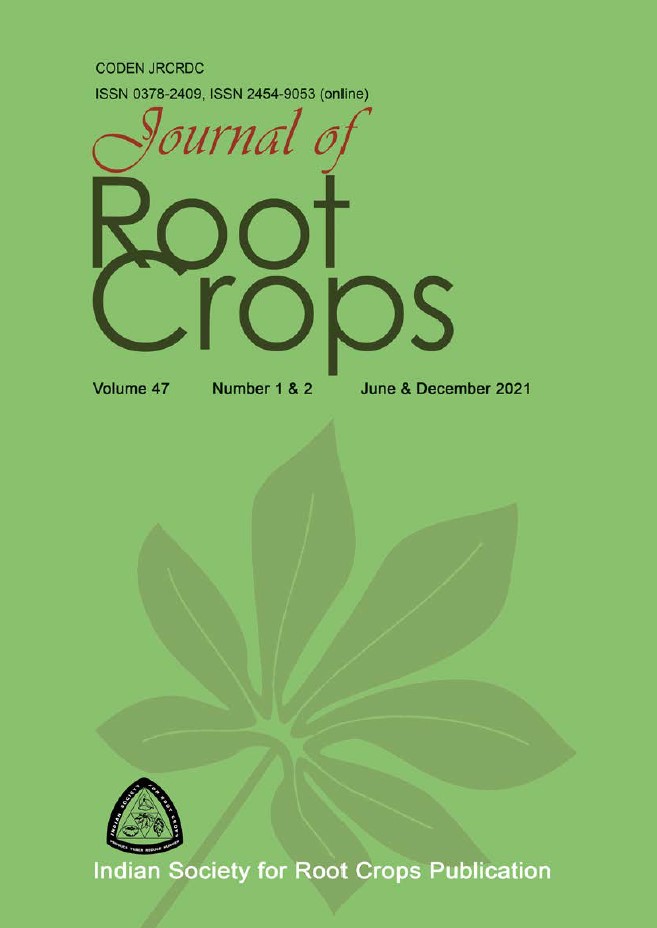Performance of improved varieties of cassava in two agroecological units of Kerala
Abstract
Cassava is an important source of energy in the diet of tropical countries of the world. It has enormous potential in India for food security and industrial uses due to its ability to grow in marginal and waste lands where other crops do not survive. Commercial planting of cassava is done from stem cuttings and because of the low multiplication rate as compared to cereals and pulses, the high yielding varieties released in the research institute takes many years to reach the farmers. Over the years, clonal multiplication degenerates the planting material, reduce tuber yield drastically and renders the cultivation of cassava uneconomical. An attempt was made to see the performance of improved varieties of cassava in Mattathur gram panchayat of Thrissur district which falls under Northern laterites Agro Ecological Unit 11 (AEU11) and Vellamunda panchayat of Wayanad district under Wayanad Central Plateau Agro Ecological Unit 21 (AEU21) of Kerala. The programme was implemented under theproject on Development of Tuber Crops financed by Government of Kerala during 2014-15 and 2015-16 undertaken by ICAR-Central Tuber Crops Research Institute, Thiruvananthapuram, Kerala. Hundred farmers were selected from Mattathur Krishi Bhavan of Thrissur districtand fifty farmers from Vellamunda Krishi Bhavan of Wayanad district. Quality planting materials of improved varieties of cassava from ICAR-CTCRI viz., Sree Jaya, Sree Vijaya, Sree Pavithra, CTM 820 and CTM 806 were distributedto the farmers for cultivation in area of 10 cents of each, with a total areaof 6 ha. The cultivation of cassava was carried out under rainfed conditions with the guidance and the direct supervision of ICAR-CTCRI scientists. Farmers got an average tuber yield of 5.40 kg and 3.70 kg per plant with an average number of tubers 6.30 and 4.68 per plantin Mattathur and Vellamunda, respectively. Improved varieties of cassava produced significantly higher average tuber yield of 66.67 t ha-1 and 45.68 t ha-1 at Mattathur and Vellamunda, respectively. In both the locations, farmers could also produce 1.50 lakhs stems of improved varieties of cassava from 6 ha area within one season which were distributed to neighboring farmers and nearby districts for cultivation in an area of 60 ha.Downloads
Published
How to Cite
Issue
Section
License
Dear Author(s)
We need your written permission before we can publish your accepted article in the Journal of Root Crops. Please read this form carefully, complete it and palace your signature below. A scanned copy of this form may be mailed to us within two days of receipt of this letter. Our email ID is: isrc_ctcri@yahoo.com or editor_jrc@yahoo.com or sreekumarctcri@gmail.com
Details:
In consideration of the publication in the Journal of Root Crops of our contribution entitled
(Name of the paper): .................................................................................................................
.................................................................................................................................................... by us (all Authors’ names) ..........................................................................................................
....................................................................................................................................................
A. To be filled in if copyright belongs to you
I/we hereby assign to Indian Society for Root Crops, Thiruvananthapuram, India, the full copyright in all forms and media in the said contribution, including open/ restricted access to online version. They own the rights to freely grant or distribute the paper to any third party or public
Please tick this box if you are the sole author of the paper
Please tick this box if you are authorised to execute this copyright transfer on behalf of all the authors of the above article
Name (block letters): . . . . . . . . . . . . . . . . . . . . . . . . . . . . . . . . . . . . . . .......
Institution/Company:..................................................................................................................
....................................................................................................................................................
Signature:.....................................................................; Date: ....................................................
B. To be filled in if copyright does not belong to you
1. Name and address of copyright holder:................................................................................
........................................................................................................................................................................................................................................................................................................
2. The copyright holder hereby grants Indian Society for Root Crops, Thiruvananthapuram, India the full copyright in all forms and media in the said contribution, including open/ restricted access to online version. They own the rights to freely grant or distribute the paper to any third party or public.
(Signature of copyright holder or authorised agent)





